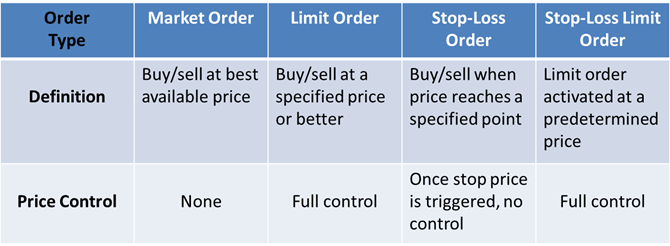This blog post is relevant to institutional investors interested in trading exchange-traded funds (ETFs) in significant volume. Individual investors do not always have access to liquidity providers to trade ETFs as referenced below.
You may have heard time and time again that exchange-traded funds (ETFs) are bought and sold just like stocks on an exchange. While this is true, it is important to understand the various order types used to execute ETFs. The execution portion of an ETF investment is often underemphasized, but it can be costly if not traded correctly. Investors need to be familiar with the basic order types available and with how to access their
ETF block desk to ensure best execution. Furthermore, they need to be well-versed in their respective order entry system. Here are some of the basic terms used for ETF trading.
Market versus Limit Orders
Market and limit orders are the two most basic order types available – and the difference between the two is vital.
A market order is an order to buy or sell an ETF at the best available price immediately. There is no price control, and while it typically ensures instant execution, the order may get filled at any available price, which may be far from the current
bid offer, especially during times of market
volatility.
A limit order is an order to buy or sell an ETF with a restriction on the maximum or minimum price to be paid. A buy limit order can only be executed at the limit price or lower and a sell limit order can only be executed at the limit price or higher. While limit orders are not guaranteed to fully execute, they protect the investor against an unforeseen market move or a momentary lack of deep bids and offers. We always recommend utilizing limit orders in a reasonable range of fair value with the understanding that a limit order does not ensure execution.
Stop-Loss Orders versus Stop-Loss Limit Orders
A stop-loss order is an order to buy or sell an ETF at the market price once the ETF has traded at or through your specified or “
stop price.” Once the stop price is triggered, the order turns into a market order. This order is designed as an automatic trigger to immediately trade if the market breaks through a set price threshold. Stop-loss orders can be very dangerous, especially in times of market volatility, and they were a contributing factor to
large price swings on August 24, 2015.
1
A stop-loss limit order is an order to buy or sell an ETF at the market price once the ETF has traded at or through a stop price, but with a limit price attached to it. The goal here is to activate a limit order at a specified price. As mentioned above, we always recommend utilizing limits when trading, as it gives the investor price control of his or her orders. Just like limit orders, stop-loss limit orders do no ensure execution.
Block Execution
When trading a large block of an ETF or trading an ETF that has lower volume on exchange, it is important to employ all tools available, especially your block ETF desk. Many investors believe that only large institutions have access to liquidity providers, who
can access the underlying liquidity of an ETF, but that is not the case. Firms like Charles Schwab, TD Ameritrade or Fidelity as well as all the
wirehouse platforms typically have block desks to utilize as a resource, and these are just a few examples. Almost all custodian and wirehouse broker-dealers have agency block execution desks available as a resource to their clients. While each platform has its own system, it is key to note that the client must select his or her order as “
not held” in order to allow the platform desk to execute on the client’s behalf. An order marked or defaulted to “held” will be sent directly to the market and executed without discretion. The Capital Markets team at WisdomTree is always available to guide institutional investors on best trading practices and help them understand all their trading outlets.
Trading Best Practices
1.
Avoid trading during the first or last 15 minutes of the trading day. This is when trade desks have less transparency and when markets are more volatile.
2.
Place limit orders; do not use market orders. In times of volatility, we advise investors not to use market orders, especially those connected to stop orders.
3.
Know your resources. Utilize your block trading desk, and if you have not worked with them before, understand their process, so you are prepared when it is time to trade. Get to know the capital markets desks at the various issuers, as they can help you navigate your trading processes.
 1
1Please note: The New York Stock Exchange (NYSE) no longer accepts or honors stop-loss orders as of February 26, 2016.


 1Please note: The New York Stock Exchange (NYSE) no longer accepts or honors stop-loss orders as of February 26, 2016.
1Please note: The New York Stock Exchange (NYSE) no longer accepts or honors stop-loss orders as of February 26, 2016.


 1Please note: The New York Stock Exchange (NYSE) no longer accepts or honors stop-loss orders as of February 26, 2016.
1Please note: The New York Stock Exchange (NYSE) no longer accepts or honors stop-loss orders as of February 26, 2016.